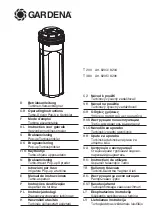
Cleaning Procedures
1) Shut off the source water supply to the RO system.
2) Open the RO faucet and depressurize the RO system and storage tank.
3) Remove pre-filter cartridges, post-filter cartridges, and RO membrane. Discard or prepare for cleaning. If the RO membrane element
is to be reused, disinfectant solution should be introduced into the permeate tube outlet sufficient to remove biofilm in this vulner-
able area, before reinserting the membrane into the housing. Use ¼ teaspoon (1ml) of unscented 5.25% sodium hypochlorite liquid
household bleach.
4) Wash the internal housing areas with warm soapy water using a clean brush (do not scratch the surface of the housings). Be sure to
clean o-ring grooves thoroughly. Remove the existing o-ring. Discard o-ring or prepare for cleaning.
5) Rinse off all housing pieces with clean water to remove soap.
6) Replace o-rings, and lubricate with a water soluable lubricant. KY Jelly® or other non petroleum water based lubricants may be
used..
7) Pour about ¼ teaspoon (1ml) of unscented 5.25% sodium hypochlorite liquid household bleach into each of the clean housings and
replace housings on the RO system.
8) Disconnect RO storage tank from the system.
9) RO storage tank cleaning procedure:
Recommended items:
• Tank sanitizer feeder or small filter housing with fittings and tubing
• Disinfectant solution
• Pressure gauge and air pump
a) The tank should be empty. Check the air pre-charge pressure with an accurate gauge (low pressure type 0-12 lbs.). The average
tank pressure should be 5-7psi (when the tank is empty).
b) Fill the tank sanitizer feeder with the recommended disinfectant dosage, and connect the feeder to the water supply and RO
storage tank.
c) Turn on water supply and force water and disinfectant solution into the RO storage tank. The storage tank should feel heavy
when filled.
d) The disinfectant solution should remain in the tank a minimum of 10 minutes. If the tank has not been sanitized in over a year,
leave the solution in for 20 to 30 minutes. Turn off the water supply valve and the RO storage tank valve. Disconnect the sanitizer
feeder, and connect the RO storage tank to the RO unit (the tank ball valve should remain closed).
10) Open the feed water valve and open the RO faucet until water flows freely from the spout. Close the RO faucet. Hold the
disinfectant solution in the RO system, including the tubing and faucet, for a minimum of 10 minutes. Open the tank ball valve.
11) Shut off the feed water valve and open the RO faucet. Let water run out until the flow stops at the RO faucet.
12) Open the feed water valve. Let water flow freely from the faucet for three minutes. Shut off the water at the source water supply
with RO faucet open.
13) When the flow of water has stopped at the RO faucet, remove the filter housing sumps and membrane housing from the RO
system. Replace the filters and membrane according to the service life.
14) Replace the housings on the RO system. Open the source water valve and allow the water to flow from the faucet.
• Because some of the disinfectant may still be in the system, the system should be flushed prior to using the water human
consumption.
• A maintenance record should be kept for the RO system, including information about the replacement parts, when service was
performed, and by whom.






































